ASRock Industrial NUC BOX-N97 and GMKtec NucBox G2 Review: Contrasting Compact ADL-N Options
by Ganesh T S on October 6, 2023 9:45 AM EST- Posted in
- Systems
- UCFF
- Mini-PC
- ASRock Industrial
- Alder Lake-N
- micro-PC
- GMKtec
System Performance: Miscellaneous Workloads
Standardized benchmarks such as UL's PCMark 10 and BAPCo's SYSmark take a holistic view of the system and process a wide range of workloads to arrive at a single score. Some systems are required to excel at specific tasks - so it is often helpful to see how a computer performs in specific scenarios such as rendering, transcoding, JavaScript execution (web browsing), etc. This section presents focused benchmark numbers for specific application scenarios.
3D Rendering - CINEBENCH R23
We use CINEBENCH R23 for 3D rendering evaluation. R23 provides two benchmark modes - single threaded and multi-threaded. Evaluation of different PC configurations in both supported modes provided us the following results.
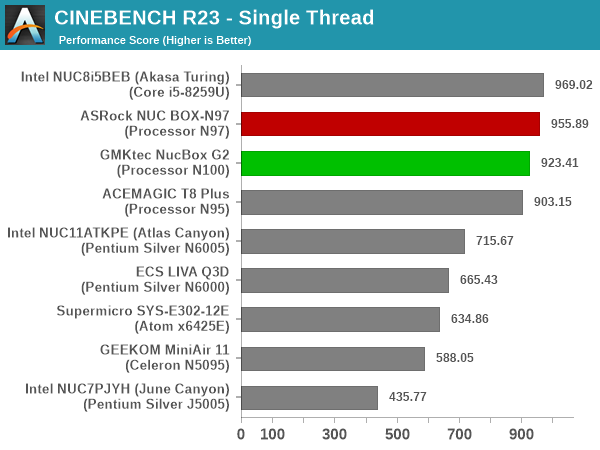

The 2W edge in the PL1 gives the NUC BOX-N97 the honors in the single-threaded rendering performance. However, with multiple threads in the picture, the systems are bunched together and the scores for all of them are within the realm of run-to-run variations.
Transcoding: Handbrake 1.5.1
Handbrake is one of the most user-friendly open source transcoding front-ends in the market. It allows users to opt for either software-based higher quality processing or hardware-based fast processing in their transcoding jobs. Our new test suite uses the 'Tears of Steel' 4K AVC video as input and transcodes it with a quality setting of 19 to create a 720p AVC stream and a 1080p HEVC stream.
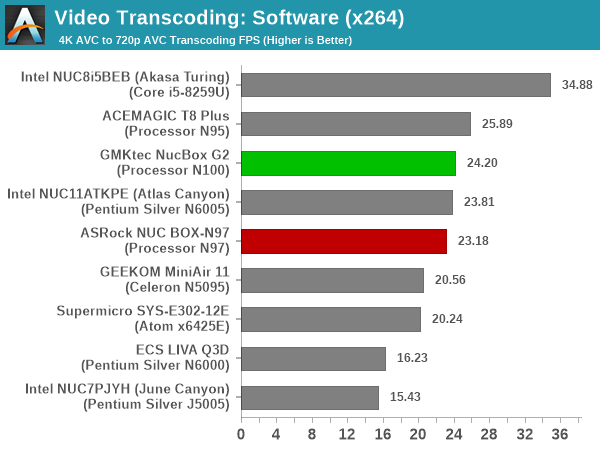
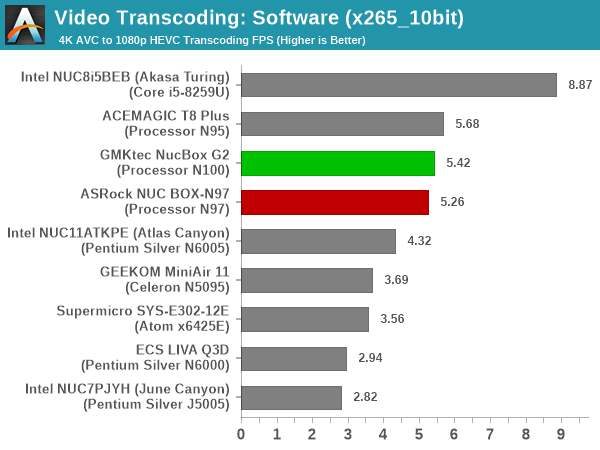
Software transcoding should ideally just be dependent on the number of cores and power limits. However, despite the 2W edge, the NUC BOX-N97 drops down a bit compared to both the NucBox G2 and the T8 Plus. The only reasonable explanation appears to the use of LPDDR5 in the latter two systems. The higher PL1 (15W) of the T8 Plus gives it the edge despite the slower LPDDR5 memory.
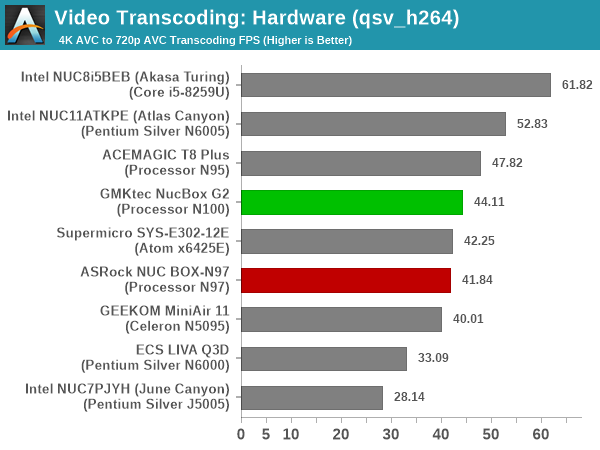
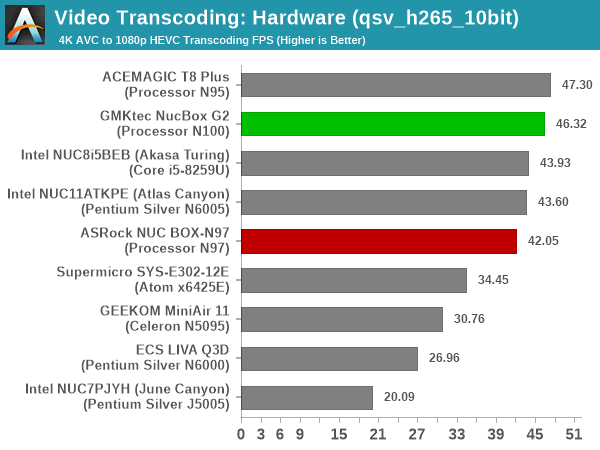
The 15W PL1 of the T8 Plus puts it above the NucBox G2 and the NUC BOX-N97, and between the latter two, the faster LPDDR5 memory seems to positively impact the G2.
Archiving: 7-Zip 21.7
The 7-Zip benchmark is carried over from our previous test suite with an update to the latest version of the open source compression / decompression software.
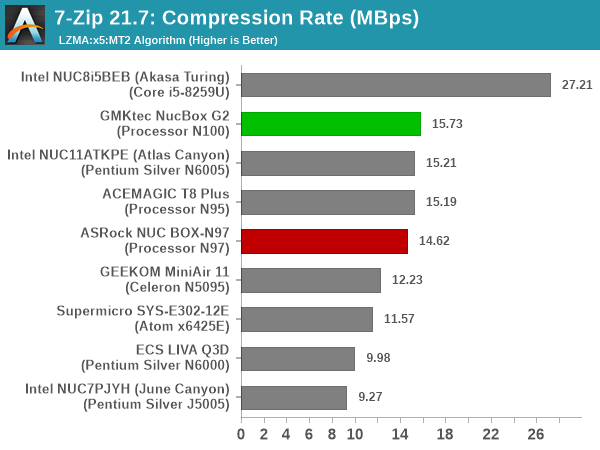
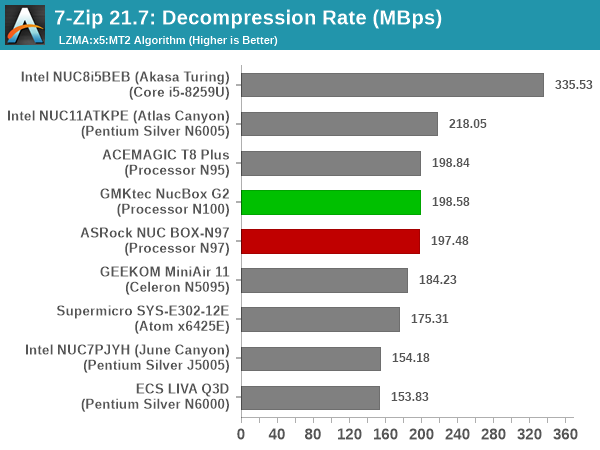
The numbers for the three ADL-N systems are close together. The edge seems to be with the NucBox G2, with its LPDDR5-4800 memory.
Web Browsing: JetStream, Speedometer, and Principled Technologies WebXPRT4
Web browser-based workloads have emerged as a major component of the typical home and business PC usage scenarios. For headless systems, many applications based on JavaScript are becoming relevant too. In order to evaluate systems for their JavaScript execution efficiency, we are carrying over the browser-focused benchmarks from the WebKit developers used in our notebook reviews. Hosted at BrowserBench, JetStream 2.0 benchmarks JavaScript and WebAssembly performance, while Speedometer measures web application responsiveness.


From a real-life workload perspective, we also process WebXPRT4 from Principled Technologies. WebXPRT4 benchmarks the performance of some popular JavaScript libraries that are widely used in websites.
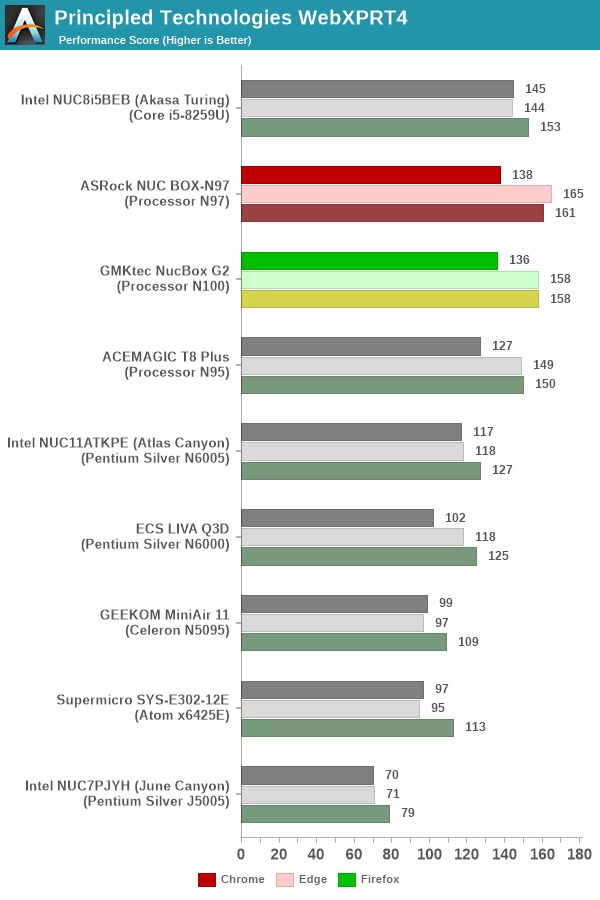
Single-threaded performance is important here, and the 2W PL1 edge gives the NUC BOX-N97 a leg up. This is particularly seen with the Edge browser. Overall, we find the scores largely tallying with each other across the same browsers.
Application Startup: GIMP 2.10.30
A new addition to our systems test suite is AppTimer - a benchmark that loads up a program and determines how long it takes for it to accept user inputs. We use GIMP 2.10.30 with a 50MB multi-layered xcf file as input. What we test here is the first run as well as the cached run - normally on the first time a user loads the GIMP package from a fresh install, the system has to configure a few dozen files that remain optimized on subsequent opening. For our test we delete those configured optimized files in order to force a ???fresh load??? every second time the software is run.
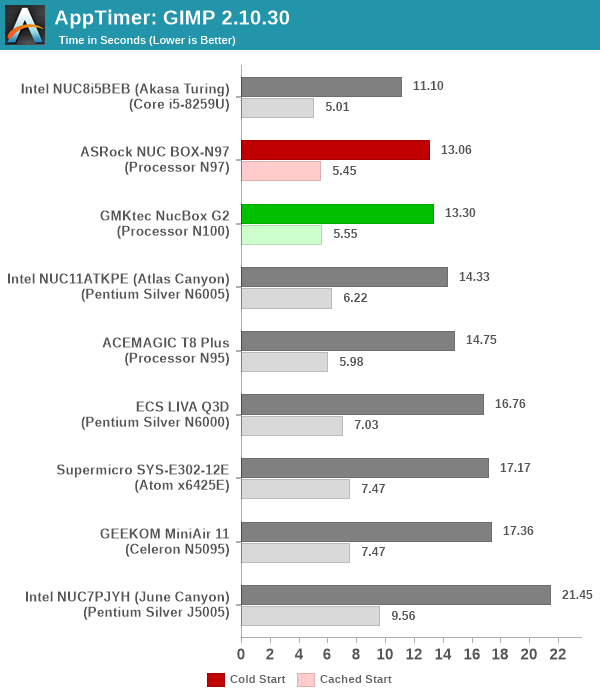
As it turns out, GIMP does optimizations for every CPU thread in the system, which requires that higher thread-count processors take a lot longer to run. So the test runs quick on systems with fewer threads, however fast cores are also needed. Both PL1 and PL2 settings help here, which is why the T8 Plus's 15W / 15W is not effective enough against the NUC BOX-N97's 12W / 25W and the NucBox G2's 10W / 25W. The 2W edge for the N97 is reflected in the above graph.
Cryptography Benchmarks
Cryptography has become an indispensable part of our interaction with computing systems. Almost all modern systems have some sort of hardware-acceleration for making cryptographic operations faster and more power efficient. In the case of IoT servers, many applications - including web server functionality and VPN - need cryptography acceleration.
BitLocker is a Windows features that encrypts entire disk volumes. While drives that offer encryption capabilities are dealt with using that feature, most legacy systems and external drives have to use the host system implementation. Windows has no direct benchmark for BitLocker. However, we cooked up a BitLocker operation sequence to determine the adeptness of the system at handling BitLocker operations. We start off with a 4.5GB RAM drive in which a 4GB VHD (virtual hard disk) is created. This VHD is then mounted, and BitLocker is enabled on the volume. Once the BitLocker encryption process gets done, BitLocker is disabled. This triggers a decryption process. The times taken to complete the encryption and decryption are recorded. This process is repeated 25 times, and the average of the last 20 iterations is graphed below.
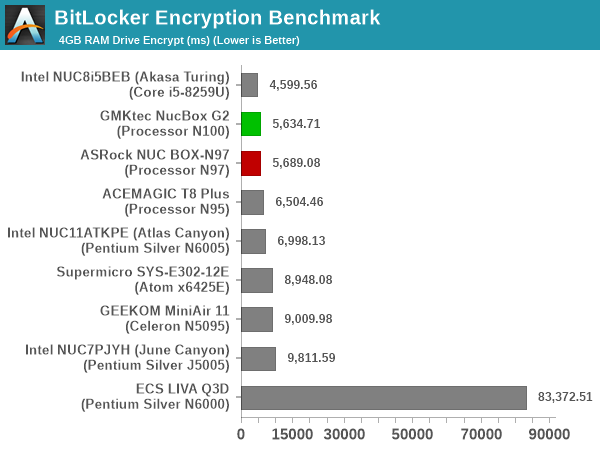
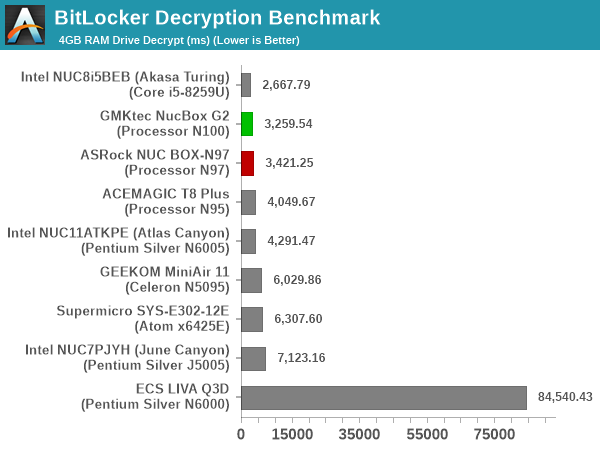
Hardware acceleration is available for the operations in all of the systems. The time taken for processing is directly dependent on the available power budget and the RAM speed, which gives the NucBox G2 a slight edge.










20 Comments
View All Comments
markiz - Tuesday, October 17, 2023 - link
Is support really at all important, or at all, with machines like these?I've had a couple of PC over the years and they all lasted 10+ years with no failers of any compononets.
Nor as a home user have I ever considered BIOS update.
I imagine in business settings it's much different.
hubick - Sunday, October 8, 2023 - link
"and soldered RAM is not being met with as much derision as before."this is where I stopped reading this article.
meacupla - Sunday, October 8, 2023 - link
It's 12GB LPDDR5 on a 6W Celeron. It's fine.Even 8GB works fine at 1440p on that CPU.
4K, you might want 16GB.
mode_13h - Monday, October 9, 2023 - link
> It's 12GB LPDDR5 on a 6W Celeron.Did you see the power consumption measurements? These things don't even *idle* at 6W!
mode_13h - Sunday, October 8, 2023 - link
> The key aspect ... is the presence of the 'In-Band ECC' option.> ...
> We confirmed ... that this option would not be removed in a future BIOS version
> Apparently, Intel has decided to allow In-Band ECC as an official feature of the ... N97.
Excellent! Thank you!
If only they had used DDR5, this might be my next mini-PC!
> MemTest86 hang during memory testing of a known faulty SODIMM
> instead of reporting errors).
LOL, wut? I hope that's a Memtest86 bug, and not just what happens when you get memory errors with IB-ECC!
ganeshts - Sunday, October 8, 2023 - link
Faulty SODIMMs can't guarantee only one- or two-bit errors. There could be more.The likely explanation for the hang is that IB ECC generates an ECC mismatch interrupt internally to the processor, and MemTest86 is not able to handle it.
MemTest86 will eventually need to add support for IB ECC interrupt handling / error status readouts.
mode_13h - Sunday, October 8, 2023 - link
Thanks for the review & replying to me.> Faulty SODIMMs can't guarantee only one- or two-bit errors. There could be more.
Okay, I sort of assumed you had some idea of how many errors the DIMM had, like based on doing a memtest scan with ECC disabled. I've seen my share of DIMMs with only a handful of bad cells, so I assumed it was one of those.
> MemTest86 will eventually need to add support for IB ECC interrupt handling / error status readouts.
Yes. Sounds like a feature they need to add. Is this the memtest variant from PassMark Software?
ganeshts - Monday, October 9, 2023 - link
Yes, I am using the PassMark variant.I have screenshots from mem testing the same SODIMM with the NUCS BOX-1360P/D4 (when they had the IB ECC feature enabled in the BIOS):
https://www.anandtech.com/show/18732/asrock-indust...
mode_13h - Monday, October 9, 2023 - link
Submit a bug report on it For Great Justice!NextGen_Gamer - Tuesday, October 10, 2023 - link
@Ganesh T S - I don't think those memory bandwidth figures and specs are correct. GPU-Z is known to not have good support for Intel's lower-end line. I know this personally as an owner of the Intel NUC11ATKPE ("Jasper Lake"). Intel's ark website shows that Alder Lake-N has a single memory channel (64-bit). Running at its fastest, so either DDR5-4800 or LPDDR5-4800, would be 38.4GB/sec of bandwidth. That tracks and make sense with what Intel says their 13th-gen Core series max bandwidth is, being dual-channel DDR5-5600, at 89.6GB/sec.Alder Lake-N running in its single-channel DDR4-3200 config then should be only 25.6GB/sec.